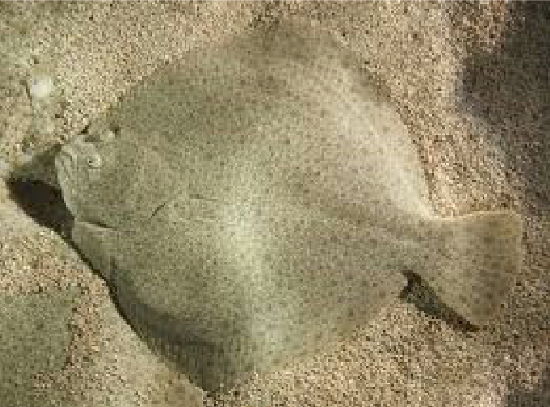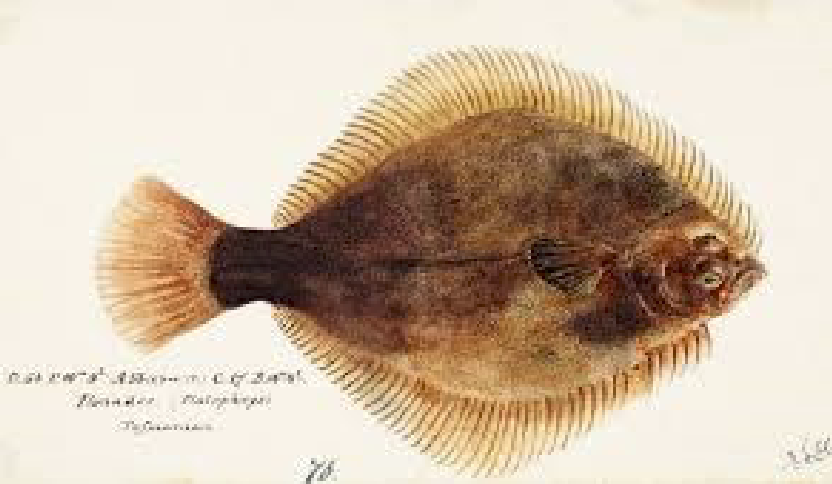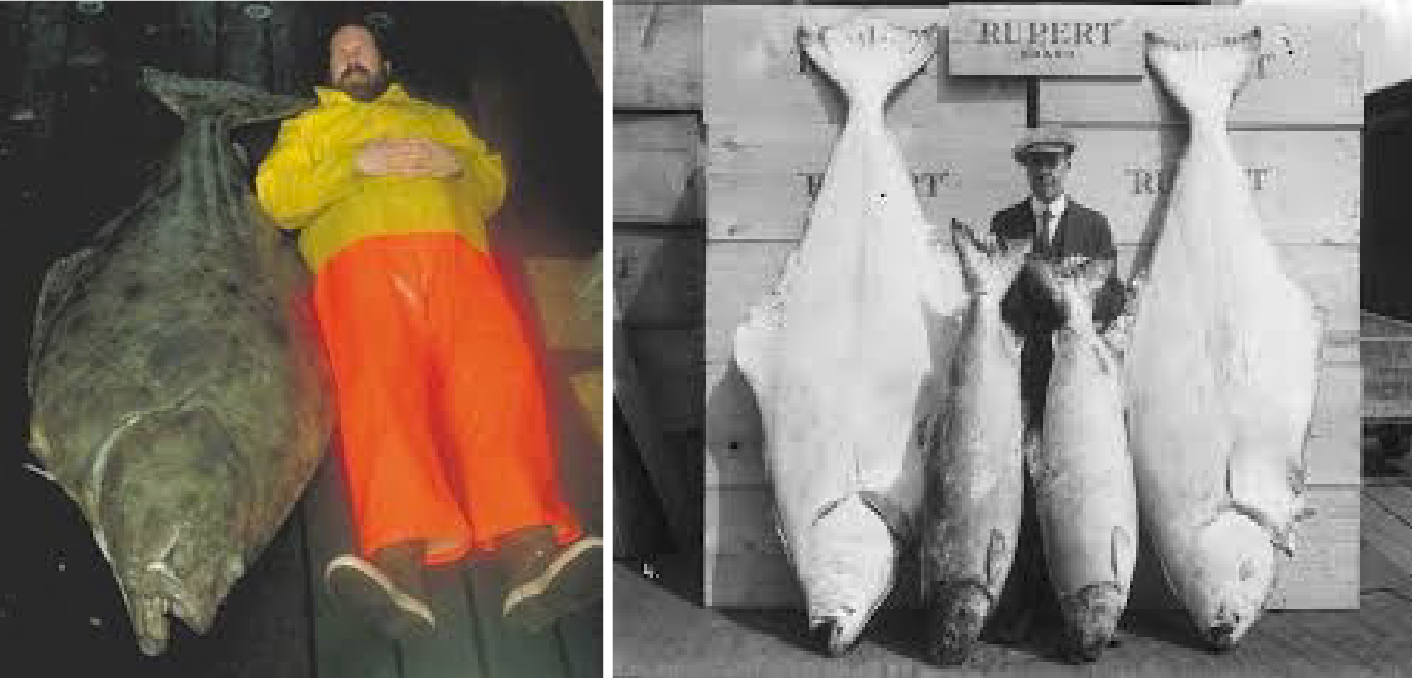3.3: Flat Fish
- Page ID
- 21274
\( \newcommand{\vecs}[1]{\overset { \scriptstyle \rightharpoonup} {\mathbf{#1}} } \)
\( \newcommand{\vecd}[1]{\overset{-\!-\!\rightharpoonup}{\vphantom{a}\smash {#1}}} \)
\( \newcommand{\id}{\mathrm{id}}\) \( \newcommand{\Span}{\mathrm{span}}\)
( \newcommand{\kernel}{\mathrm{null}\,}\) \( \newcommand{\range}{\mathrm{range}\,}\)
\( \newcommand{\RealPart}{\mathrm{Re}}\) \( \newcommand{\ImaginaryPart}{\mathrm{Im}}\)
\( \newcommand{\Argument}{\mathrm{Arg}}\) \( \newcommand{\norm}[1]{\| #1 \|}\)
\( \newcommand{\inner}[2]{\langle #1, #2 \rangle}\)
\( \newcommand{\Span}{\mathrm{span}}\)
\( \newcommand{\id}{\mathrm{id}}\)
\( \newcommand{\Span}{\mathrm{span}}\)
\( \newcommand{\kernel}{\mathrm{null}\,}\)
\( \newcommand{\range}{\mathrm{range}\,}\)
\( \newcommand{\RealPart}{\mathrm{Re}}\)
\( \newcommand{\ImaginaryPart}{\mathrm{Im}}\)
\( \newcommand{\Argument}{\mathrm{Arg}}\)
\( \newcommand{\norm}[1]{\| #1 \|}\)
\( \newcommand{\inner}[2]{\langle #1, #2 \rangle}\)
\( \newcommand{\Span}{\mathrm{span}}\) \( \newcommand{\AA}{\unicode[.8,0]{x212B}}\)
\( \newcommand{\vectorA}[1]{\vec{#1}} % arrow\)
\( \newcommand{\vectorAt}[1]{\vec{\text{#1}}} % arrow\)
\( \newcommand{\vectorB}[1]{\overset { \scriptstyle \rightharpoonup} {\mathbf{#1}} } \)
\( \newcommand{\vectorC}[1]{\textbf{#1}} \)
\( \newcommand{\vectorD}[1]{\overrightarrow{#1}} \)
\( \newcommand{\vectorDt}[1]{\overrightarrow{\text{#1}}} \)
\( \newcommand{\vectE}[1]{\overset{-\!-\!\rightharpoonup}{\vphantom{a}\smash{\mathbf {#1}}}} \)
\( \newcommand{\vecs}[1]{\overset { \scriptstyle \rightharpoonup} {\mathbf{#1}} } \)
\( \newcommand{\vecd}[1]{\overset{-\!-\!\rightharpoonup}{\vphantom{a}\smash {#1}}} \)
\(\newcommand{\avec}{\mathbf a}\) \(\newcommand{\bvec}{\mathbf b}\) \(\newcommand{\cvec}{\mathbf c}\) \(\newcommand{\dvec}{\mathbf d}\) \(\newcommand{\dtil}{\widetilde{\mathbf d}}\) \(\newcommand{\evec}{\mathbf e}\) \(\newcommand{\fvec}{\mathbf f}\) \(\newcommand{\nvec}{\mathbf n}\) \(\newcommand{\pvec}{\mathbf p}\) \(\newcommand{\qvec}{\mathbf q}\) \(\newcommand{\svec}{\mathbf s}\) \(\newcommand{\tvec}{\mathbf t}\) \(\newcommand{\uvec}{\mathbf u}\) \(\newcommand{\vvec}{\mathbf v}\) \(\newcommand{\wvec}{\mathbf w}\) \(\newcommand{\xvec}{\mathbf x}\) \(\newcommand{\yvec}{\mathbf y}\) \(\newcommand{\zvec}{\mathbf z}\) \(\newcommand{\rvec}{\mathbf r}\) \(\newcommand{\mvec}{\mathbf m}\) \(\newcommand{\zerovec}{\mathbf 0}\) \(\newcommand{\onevec}{\mathbf 1}\) \(\newcommand{\real}{\mathbb R}\) \(\newcommand{\twovec}[2]{\left[\begin{array}{r}#1 \\ #2 \end{array}\right]}\) \(\newcommand{\ctwovec}[2]{\left[\begin{array}{c}#1 \\ #2 \end{array}\right]}\) \(\newcommand{\threevec}[3]{\left[\begin{array}{r}#1 \\ #2 \\ #3 \end{array}\right]}\) \(\newcommand{\cthreevec}[3]{\left[\begin{array}{c}#1 \\ #2 \\ #3 \end{array}\right]}\) \(\newcommand{\fourvec}[4]{\left[\begin{array}{r}#1 \\ #2 \\ #3 \\ #4 \end{array}\right]}\) \(\newcommand{\cfourvec}[4]{\left[\begin{array}{c}#1 \\ #2 \\ #3 \\ #4 \end{array}\right]}\) \(\newcommand{\fivevec}[5]{\left[\begin{array}{r}#1 \\ #2 \\ #3 \\ #4 \\ #5 \\ \end{array}\right]}\) \(\newcommand{\cfivevec}[5]{\left[\begin{array}{c}#1 \\ #2 \\ #3 \\ #4 \\ #5 \\ \end{array}\right]}\) \(\newcommand{\mattwo}[4]{\left[\begin{array}{rr}#1 \amp #2 \\ #3 \amp #4 \\ \end{array}\right]}\) \(\newcommand{\laspan}[1]{\text{Span}\{#1\}}\) \(\newcommand{\bcal}{\cal B}\) \(\newcommand{\ccal}{\cal C}\) \(\newcommand{\scal}{\cal S}\) \(\newcommand{\wcal}{\cal W}\) \(\newcommand{\ecal}{\cal E}\) \(\newcommand{\coords}[2]{\left\{#1\right\}_{#2}}\) \(\newcommand{\gray}[1]{\color{gray}{#1}}\) \(\newcommand{\lgray}[1]{\color{lightgray}{#1}}\) \(\newcommand{\rank}{\operatorname{rank}}\) \(\newcommand{\row}{\text{Row}}\) \(\newcommand{\col}{\text{Col}}\) \(\renewcommand{\row}{\text{Row}}\) \(\newcommand{\nul}{\text{Nul}}\) \(\newcommand{\var}{\text{Var}}\) \(\newcommand{\corr}{\text{corr}}\) \(\newcommand{\len}[1]{\left|#1\right|}\) \(\newcommand{\bbar}{\overline{\bvec}}\) \(\newcommand{\bhat}{\widehat{\bvec}}\) \(\newcommand{\bperp}{\bvec^\perp}\) \(\newcommand{\xhat}{\widehat{\xvec}}\) \(\newcommand{\vhat}{\widehat{\vvec}}\) \(\newcommand{\uhat}{\widehat{\uvec}}\) \(\newcommand{\what}{\widehat{\wvec}}\) \(\newcommand{\Sighat}{\widehat{\Sigma}}\) \(\newcommand{\lt}{<}\) \(\newcommand{\gt}{>}\) \(\newcommand{\amp}{&}\) \(\definecolor{fillinmathshade}{gray}{0.9}\)Flounder have lean, firm flesh that is pearly or pinkish-white with a sweet, mild flavor. Although they are easily boned, most are de-headed and gutted at sea and sold as fresh or frozen fillets. These fillets are very thin and can dry out or spoil easily, so extra care should be taken in handling, preparing and storing them. Recipes that preserve moisture work best with flounder:poaching, steaming and frying are recommended. Many types of flounder are marketed as sole, perhaps in an attempt to cash in on the popularity of true sole. The FDA permits this practice.

Southern Flounder
Flounder (also known as Sole) By Location
Atlantic Ocean
- Black back/Winter flounder/Lemon sole Fluke/Summer flounder
- Starry flounder Yellowtail flounder Windowpane flounder
- Gray sole/Witch flounder
Pacific Ocean
- Arrow tooth
- Petrale sole Rex sole English sole Rock sole Sand sole Yellowfin sole
- Domestic Dover sole/Pacific flounder
- Butter sole
English sole are actually flounder caught off the West Coast of the United States. They are usually marketed simply as "fillet of sole." They are a plentiful species of fair to average quality.

Petale Sole
Petrale sole, another West Coast flounder, are generally considered the finest of the domestic "soles." They are most often available as fillets, which tend to be thicker and firmer than other sole fillets.

Pacific Flounder
Domestic Dover sole are also Pacific flounder. They are not as delicate or flavorful as other species of sole or flounder. Moreover, they are often afflicted with a parasite that causes their flesh to have a slimy, gelatinous texture. Domestic Dover sole are not recommended if other sole or flounder are available.
Lemon sole are the most abundant and popular East Coast flounder. They are also known as black back or winter flounder (during the winter, they migrate close to shore from the deeper, colder waters). They average 2 pounds (900 grams) in weight

Pacific Halibut Halibut and Salmon
Halibut are among the largest flat fish; they often weigh up to 300 pounds 035 kilograms). The FDA recognizes only two halibut species: Atlantic (eastern) and Pacific (northern, Alaskan, western) halibut. Both have lean, firm flesh that is snow-white with a sweet, mild flavor. California halibut, which are actually flounder, are similar in taste and texture but average only 12 pounds (5.4 kilograms) each. Halibut may be cut into boneless steaks or skewered on brochettes. The flesh, which dries out easily, can be poached, baked, grilled or broiled and is good with a variety of sauces
Sole are probably the most flavorful and finely textured flatfish. Indeed, because of the connotations of quality associated with the name, "sole" is widely used for many species that are not members of the Soleidae family. Even though the FDA allows many species of flatfish to be called "sole" for marketing purposes, no true sole is commercially harvested in American water s. Any flatfish harvested in American waters and marketed as sole is actually flounder. True Dover sole, a staple of classic cuisine, are a lean fish with pearly-white flesh and a delicate flavor that can stand up to a variety of sauces and seasonings. They are a member of the Soleidae family and come only from the waters off the coasts of England, Africa and Europe. They are imported into this country as fresh whole fish or fresh or frozen fillets.

Turbot Turbot on Sea Bottom
Turbot are a Pacific flatfish of no great culinary distinction. In Europe, how- ever, the species known as turbot are large diamond-shaped fish highly prized for their delicate flavor and firm, white flesh. They are also marketed as brill.


